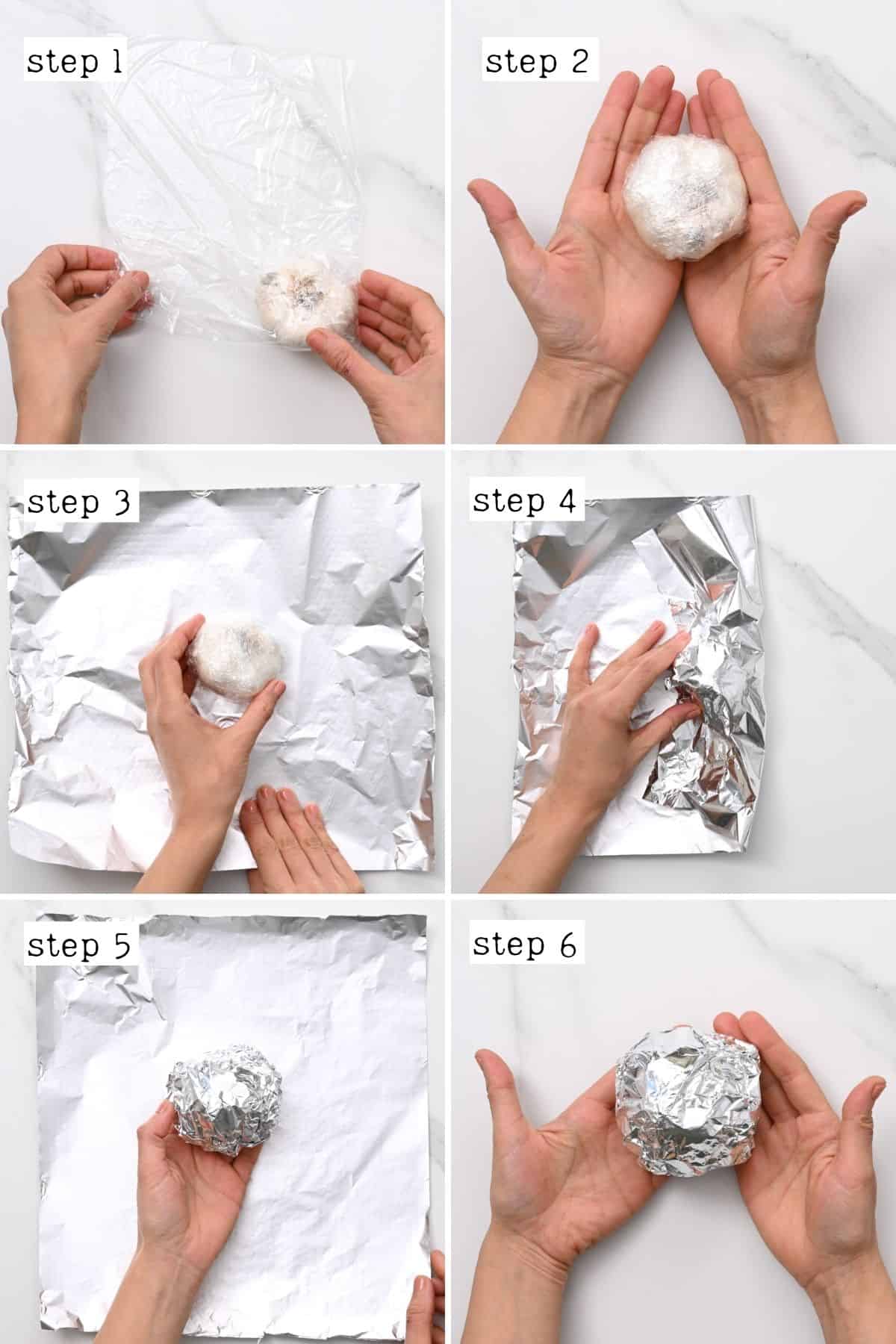If you’ve never tried black garlic before, the dark color may look less than appetizing. However, similar to roasted garlic, this aged garlic is mellow and slightly sweet. More so, it’s almost caramel or molasses-like, with a slightly sticky texture. It’s a wonderful addition to all sorts of meals.
What is black garlic?
First, let’s talk about what it is not. Black garlic is not a naturally growing variety of garlic, as you might think. Instead, it’s a type of aged garlic (also called aged garlic or fermented black garlic) that first appeared in Korea and Thailand. Controlling the heat and humidity of whole garlic bulbs over several weeks (usually at least 3 up to 12) triggers the “Maillard reaction,” which is the same process that adds flavor to fried onions, seared meat, and toasted marshmallows. By the end of the process, the raw garlic bulbs are transformed into mild, sweet, slightly molasses/balsamic-like black garlic with a sticky, almost date-like texture and very little smell. At this stage, the ingredient is not only impressive addition to high-end dishes at many restaurants but it’s also revered as a health product, with several health benefits (listed below).
What are black garlic health benefits?
When comparing black garlic vs. garlic: along with the change in color, flavor, and texture, it also boasts some different health benefits.
For example, black garlic contains more antioxidants in substantial amounts, with great anti-cancer properties. This is particularly the case with S-allyl cysteine, which helps the body absorb allicin, as well as arginine, polyphenol, and amino acids. The combination is beneficial towards immunity, blood sugar levels, wound healing, collagen production, preventing clots, digestion, preventing fatigue, boosting performance, and brain health. It may also help reduce harmful cholesterol while increasing “good” HDL cholesterol levels. Black garlic helps regulate blood sugar levels, including other metabolic results, including lowered cholesterol and appetite regulation. The anti-inflammatory benefits are perfect for protecting against several chronic diseases and cancers and protecting brain function and health. It’s also anti-allergy (as it decreases reaction to immunoglobulin E, which causes allergies), anti-carcinogenic, immune-boosting, and can be beneficial for diabetes management. Read more about the health benefits of black garlic on Healthline and WebMD.
How to make black garlic
Making black garlic is very simple and hands-off, though it takes several weeks to complete.
Step 1: Prepare the garlic
First, I like to clean the garlic bulbs. Simply use a clean kitchen towel or scrubbing brush to gently remove any dirt. Don’t wet the garlic at all. Then, wrap the whole bulbs tightly in cling film before adding two layers of aluminum foil. Alternatively, you may be able to place several garlic bulbs in a single mason jar with the lid on. I haven’t tried this method, but it should work.
Step 2: Leave it to ferment
In a rice cooker/slow cooker: use the keep warm function (not LOW) and place the wrapped garlic bulbs in it for between 3-4 weeks. If your machine auto shuts off, make sure to remember to turn it on again when needed. Note that once you’ve done this method once, the smell of garlic will linger forever in the appliance. In a dehydrator: this is my preferred method for complete temperature control using an appliance designed for use over long periods. Set it to 140ºF/60ºC and leave the garlic bulbs to age for 4 weeks. A proofer: This isn’t a method I’ve tried as I don’t own a proofer. However, it is another option. Not only are proofers perfect for maintaining long periods of low temperatures (used to make bread, yogurt, etc.) and humidity, but they’re also usually cheaper to run. The process will require a minimum of 3-4 weeks but can be left to age for up to 60 days, depending on the exact results you want. During the process, the garlic will become very hard before it softens and becomes sticky-chewy; this is when they’re ready, though they can be aged even further if preferred. To test their doneness, press against a clove to feel if it’s soft. It should be slightly sticky/chewy like a date. You could also remove a single clove to test the flavor.
Bonus: How to make black garlic powder
After the garlic has sufficiently aged, peel the papery skin on all the cloves. Then spread them over a dehydrator rack and dehydrate at 140ºF/60ºC for 24-26 hours until they are light and completely dry. The exact time will depend on the climate/humidity, size of the cloves, your particular dehydrator. Check at 24 hours and every couple of hours after that until ready. Transfer the dried cloves to a spice grinder or high-speed blender and process them into a fine powder. Sift it, then reprocess any larger pieces. Then transfer the black garlic powder to a clean, dry, airtight jar.
Black garlic recipes and uses
Mash and spread over toast. Combine with soy sauce and chili as a simple Asian black garlic stir-fry/ramen sauce. Mix it into condiments like mayonnaise or to make a black garlic aioli for spreading over burgers and dipping with fries. Mash it into butter, like this roasted garlic butter. Mash and combine it with olive oil (or cream cheese/ricotta) to make it black garlic paste. Use it as a spread for toast, bruschetta, crackers, etc. Add the black garlic to a cheese platter or charcuterie board. Use it within vinaigrettes and salad dressings. Mix it into soups (like this roasted cauliflower soup) and curry. Add to omelettes. Add some to creamy homemade hummus or garlic white bean dip. Use it as an umami-rich pizza topper. Mash and mix into pasta dishes (like mac n’ cheese or pasta aglio e olio) or slice and serve as a garnish. Mash it into creamy black garlic mashed potatoes. Dehydrate and grind it into a black garlic powder for an umami boost to tons of meals. Use it to create marinades and sauces for meat (like chicken or steak) and fish. Thinly slice and use as a salad topper or toast topper (like with avocado toast).
Black garlic works particularly well when it’s the “hero” of a dish, too, rather than just blending into it since it’s so mellow. You can even use black garlic in several desserts such as brownies, choux, ice cream, and more. Let me know in the comments what your favorite black garlic recipes are. Fridge: I prefer to store the garlic bulbs whole in an airtight container/jar and remove and peel cloves as needed. This way, they’ll store for up to 6 months. Freeze: you can store the entire garlic bulb or separate them into cloves first. I usually leave mine unpeeled. Wrap them tightly with plastic wrap and then store them in the freezer for up to 12 months. It doesn’t freeze solid, so it can be used fairly quickly after removing it from the freezer. If you fully peel the garlic or make it into a paste, etc., I recommend storing it in an airtight container in the fridge and aiming to use it within a month or 3 to 4 months in the freezer.
More garlic DIYs
Garlic and chili infused honey Pickled garlic Garlic powder How to peel garlic Homemade garlic paste Garlic flakes (dried) Lebanese garlic sauce (Toum)
If you try any of the methods or uses for black garlic, I’d love to hear your thoughts/questions below. Also, I’d appreciate a recipe card rating below, and feel free to tag me in your recipe recreations on Instagram @Alphafoodie!



















